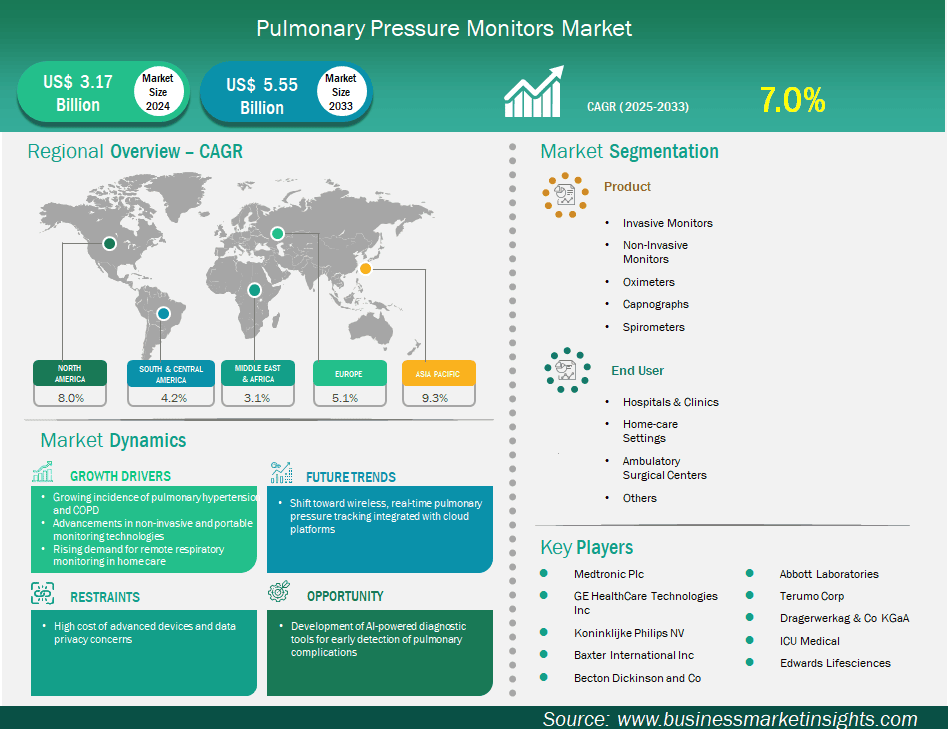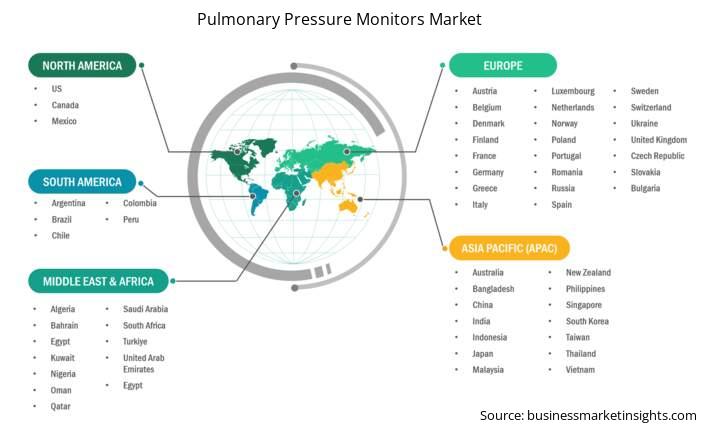Pulmonary Pressure Monitors Market Outlook (2022-2033)
No. of Pages: 200 | Report Code: BMIPUB00031764 | Category: Life Sciences
No. of Pages: 200 | Report Code: BMIPUB00031764 | Category: Life Sciences
The pulmonary pressure monitors market size is expected to reach US$ 5,551.39 million by 2033 from US$ 3,168.82 million in 2024. The market is estimated to record a CAGR of 7.0% from 2025 to 2033.
The global pulmonary pressure monitors market is experiencing significant growth driven by growing incidence of pulmonary hypertension and COPD, advancements in non-invasive and portable monitoring technologies, rising demand for remote respiratory monitoring in home care. Pulmonary pressure monitors encompass invasive monitors, non-invasive monitors, oximeters, capnographs, spirometers. The pulmonary pressure monitor market is being driven positively by the increasing global prevalence of chronic respiratory disease, such as pulmonary hypertension and chronic obstructive pulmonary disease (COPD), along with an increased incidence of heart failure. All of these conditions require continuous and accurate pressure monitoring to properly manage the disease, prevent complications, and personalize treatment.
There are plenty of innovations in this space including wireless, implantable sensors like the CardioMEMS HF System (Abbott Laboratories) that provide remote daily monitoring of pulmonary artery pressure in the setting of heart failure from the patient's house. This allows the patient to proactively manage their condition, reduces hospitalization, and a better quality of life for heart failure patients. This shift toward remote and non-invasive technologies is consistent with a much wider trend in the industry that is committed to improving patient comfort, limiting risk, and enabling patients to manage problems collaboratively with their health care provider remotely.

Key segments that contributed to the derivation of the Pulmonary Pressure Monitors market analysis are product, application, and end user.
Rising Incidence of Both Pulmonary Hypertension (PH) And Chronic Obstructive Pulmonary Disease (COPD) Driving Pulmonary Pressure Monitors Market
The rising incidence of both pulmonary hypertension (PH) and chronic obstructive pulmonary disease (COPD) is a key factor for the pulmonary pressure monitors market. Pulmonary hypertension is a severe progressive disease defined as abnormally high blood pressure in the arteries of the lungs that often leads to right heart failure; in a similar fashion, COPD is defined as a category of progressive lung diseases characterized by the obstruction and limitation of airflow - the most commonly known types are emphysema and chronic bronchitis. COPD often leads to secondary pulmonary hypertension. As the global population's age continues to rise, along with exposure to risk factors such as smoking and air pollution the appearance of both PH and COPD is increasing which creates a larger demand for diagnostic and monitoring devices that will allow for the early identification and accurate diagnosis and ongoing management of these complex cardiopulmonary diseases.
In PH (and severe COPD) patients, monitoring pulmonary pressure constantly or periodically over time is important so clinicians can follow the disease progress, evaluate the outcomes of therapies, and to avert acute exacerbations or situations that can lead to problems, such as right heart failure. Although right heart catheterization is an invasive procedure and remains the gold standard for definitive diagnosis and accurate measured values, the demand for the catheters and transducers remains a large requirement.
Development of AI-powered Diagnostic Tools for Early Detection of Pulmonary Complications
The integration of AI into existing pulmonary monitors enables new connections between patient data and guidelines to override possible barriers for early detection and management of complications. For example, with predictive analytics from AI-enabled pulmonary monitors, one may determine what combination of key patient variables actually predict indicators of pulmonary hypertension, and subsequently alter treatment plans. It is possible that with further research, predictive analytics may even influence the choice of treatments that best suit patients with pulmonary hypertension.
This transformative nature of AI-powered diagnostic tools also provides new opportunities for establishing technologies to monitor pulmonary pressures like direct measured (right heart catheterization,) and implantable monitoring systems (such as the CardioMEMS system) through a faster, more efficient process. AI algorithms are also greater to identify unknown risk factors in a broader community-based data set based on, for example, clinical, ECG, and/or even chest X-ray data.
Using these new AI analytical tools with clinical, standardized, and/or big pulmonary data sets, it brings closer to predicting problems before they become apparent, and initiating treatment plans based on early symptom presentation as indicators, which one may not see using traditional approaches with fewer data sources. Predictive analytics could be the new frontier to signal such a paradigm shift to potentially address pulmonary hypertension across a broader population.
The pulmonary pressure monitors market is classified according to products into invasive monitors, non-invasive monitors, oximeters, capnographs, spirometers. The invasive monitors segment led the market in 2024 and beyond. Due to its unmatched accuracy, ability to provide continuous real-time data, and the serious nature of the medical conditions it diagnoses and treats, invasive monitors are the largest segment of the pulmonary pressure monitors market. Methods such as right heart catheterization, employing pulmonary artery catheters (e.g., Swan-Ganz catheters), is the gold standard for collecting direct measurements such as pulmonary artery pressure and pulmonary capillary wedge pressure, as well as other hemodynamic measurements necessary to definitively diagnose and accurately manage pulmonary hypertension and severe heart failure. While some minimally invasive or non-invasive techniques are becoming available, these approaches often cannot simulate the same amount of data, the level of detail, or the precision in foot-pounds necessary to inform acute patient care decisions and address advanced therapeutic interventions. The ability to provide immediate, highly accurate information about a patient's cardiopulmonary status continues to make invasive monitors critical in emergency situations, intensive care units (ICUs), operating rooms (ORs), and other specialized departments such as cardiology/pulmonology where minor changes in hemodynamic from minute to minute can be fundamental to the clinical outcome for a patient.
By end user, the market is segmented into hospitals and clinics, home-care Settings, ambulatory surgical centers, others. The hospitals and clinics segment held the largest share of the market in 2024. Hospitals and clinics are the largest end-users (consumers) of pulmonary pressure monitors due to some key factors, namely the invasiveness of the primary objective measure and the clinical nature of the indicated patient. For example, right heart catheterization represents the gold standard for pulmonary pressure measurement, involves highly trained medical personnel, requires a sterile field and facility, as well as typical hospital infrastructure.
Pulmonary Pressure Monitors Market Report Highlights
Report Attribute
Details
Market size in 2024
US$ 3,168.82 Million
Market Size by 2033
US$ 5,551.39 Million
Global CAGR (2025 - 2033) 7.0%
Historical Data
2022-2023
Forecast period
2025-2033
Segments Covered
By Product
By End User
Regions and Countries Covered
North America
Europe
Asia-Pacific
South, Central America
Middle East, Africa
Market leaders and key company profiles
The "Pulmonary Pressure Monitors Market Size and Forecast (2021–2031)" report provides a detailed analysis of the market covering below areas:

The geographical scope of the pulmonary pressure monitors market report is divided into five regions: North America, Asia Pacific, Europe, Middle East & Africa, and South & Central America. The Pulmonary Pressure Monitors market in Asia Pacific is expected to grow significantly during the forecast period.
The Asia Pacific region has quickly become a major emerging market in pulmonary pressure monitoring. A number of factors contribute to this rapid growth. First of all, the Asia Pacific region is facing a growing burden of chronic respiratory and cardiovascular disease including the increasing prevalence of conditions such as pulmonary hypertension (PH) and Chronic Obstructive Pulmonary Disease (COPD). All of these conditions will require access to more sophisticated diagnostic and monitoring capabilities to more effectively manage these conditions and improve patient outcomes at a population level. Coupled with this is the ongoing improvement flowing through a number of Asia Pacific countries in healthcare infrastructure accompanied by increasing healthcare spend, and the developing awareness by both clinicians and patients of the need for early diagnosis and monitoring of pulmonary conditions. In addition, the developing capabilities in this region in manufacturing of medical devices and increasing investments in healthcare technologies is also driving this growth.
Within the Asia Pacific region there are specific countries that are contributing to driving the growth of the market. China represents a huge opportunity given its massive population, rapidly progressing healthcare system, and is a major growth driver for pulmonary pressure monitors relating specifically to the challenge of pulmonary arterial hypertension (PAH) and where healthcare reforms are improving access to specialized diagnosis.
The pulmonary pressure monitors market is evaluated by gathering qualitative and quantitative data post primary and secondary research, which includes important corporate publications, association data, and databases. A few of the key developments in the Pulmonary Pressure Monitors market are:
The Pulmonary Pressure Monitors Market is valued at US$ 3,168.82 Million in 2024, it is projected to reach US$ 5,551.39 Million by 2033.
As per our report Pulmonary Pressure Monitors Market, the market size is valued at US$ 3,168.82 Million in 2024, projecting it to reach US$ 5,551.39 Million by 2033. This translates to a CAGR of approximately 7.0% during the forecast period.
The Pulmonary Pressure Monitors Market report typically cover these key segments-
The historic period, base year, and forecast period can vary slightly depending on the specific market research report. However, for the Pulmonary Pressure Monitors Market report:
The Pulmonary Pressure Monitors Market is populated by several key players, each contributing to its growth and innovation. Some of the major players include:
The Pulmonary Pressure Monitors Market report is valuable for diverse stakeholders, including:
Essentially, anyone involved in or considering involvement in the Pulmonary Pressure Monitors Market value chain can benefit from the information contained in a comprehensive market report.